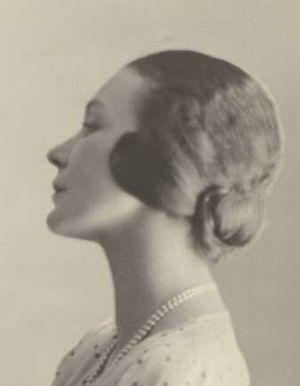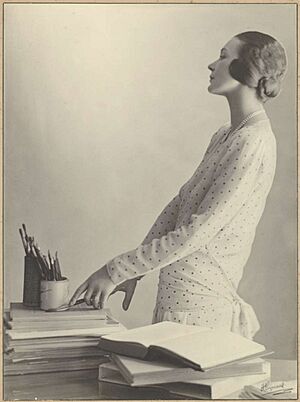Doris Zinkeisen facts for kids
Doris Clare Zinkeisen (born July 31, 1898 – died January 3, 1991) was a talented Scottish artist. She was a stage and costume designer for plays and films. She was also a painter, commercial artist, and writer. Doris Zinkeisen is most famous for her amazing work in theatre design.
Contents
Early Life and Training
Doris Zinkeisen was born in Clynder House in Rosneath, Scotland. Her mother, Clare Bolton-Charles, was Welsh. Her father, Victor Zinkeisen, was a timber merchant and amateur artist from Glasgow. The family had roots in Bohemia but had lived in Scotland for 200 years.
Doris had a younger sister, Anna Zinkeisen, who also became an artist. In 1909, her family moved from Scotland to Pinner, near Harrow. Doris studied at the Harrow School of Art for four years. In 1917, she and Anna both won scholarships. They went to the Royal Academy Schools to continue their art training.
During World War I, Doris helped as a nurse. She was part of the Voluntary Aid Detachment. She worked at a hospital in Northwood, Middlesex.
Creative Career
In the 1920s and 1930s, Doris Zinkeisen shared an art studio in London with her sister. From there, she started her career. She worked as a painter, a commercial artist, and a theatre designer.
Painting and Commercial Art
Doris Zinkeisen was known for her realistic painting style. This made her a popular portrait artist. She painted many famous people. Her paintings often showed the lives of the upper class. She painted portraits of people, horses, and scenes from parks in London and Paris. One of her early successes was a portrait of the actor Elsa Lanchester in 1925.
She also created illustrations and commercial art. She designed advertising posters for British railway companies. She also painted murals for the famous ocean liner, the RMS Queen Mary. A poster she made for the London Underground in 1939, called At the Theatre, was never used because World War II began.
In 1944, Doris and her sister Anna got a special job. They were asked by United Steel Companies to create twelve paintings. These paintings were used in newspapers and magazines in several countries. Later, they were put together in a book called This Present Age in 1946.
Railway Posters
Doris Zinkeisen made many posters for railway companies in the 1930s. These included the London and North Eastern Railway (LNER), Southern Railway (SR), and the London, Midland and Scottish Railway (LMS). Her posters often featured historical stories.
Some examples include:
- Berwick-upon-Tweed by LNER (1930): This poster showed a historical event from 1306.
- Cambridge it's Quicker by Rail (1930): For LNER, showing Queen Elizabeth I visiting Queens College in 1564.
- Durham by LNER (1932): Based on a local legend, showing pilgrims and Durham Cathedral.
- To York – Dick Turpin's Ride (1934): For LNER, featuring the famous highwayman Dick Turpin riding to York.
- Scarborough, In Grandmother's Day (1935): For LNER, showing people in Victorian clothes at Scarborough.
- The Coronation (1937): For LNER, showing a special train built for the coronation of King George VI.
- Captain Cook at Whitby (c. 1937): For LNER, showing Captain Cook in Whitby harbour. The poster mentioned his famous ships, the Endeavour and the Resolution, which were built in Whitby.
RMS Queen Mary Murals
In 1935, a shipbuilding company asked Doris and Anna Zinkeisen to paint murals. These murals were for the Verandah Grill, a restaurant on the ocean liner RMS Queen Mary. The murals showed circus and theatre scenes. You can still see them on the ship today, which is now a hotel in Long Beach, California.
Doris also helped design the inside of the Verandah Grill. It had a dance floor, special carpets, and velvet curtains. The lighting changed colors with the music. A famous photographer, Cecil Beaton, wrote in Vogue that it was "By far the prettiest room on any ship."
One of the largest murals was damaged during World War II. After the war, Doris fixed it. She even painted a tiny mouse into the mural. This was a playful jab at Cunard, the ship's owner, who were proud of having no mice on their ships! Both sisters also painted murals for another ship, the RMS Queen Elizabeth, in 1940.
Exhibitions and Awards
Doris Zinkeisen showed her art at the Royal Academy in 1929. She also exhibited in London, Paris, and the United States. She won several medals for her work at the Paris Salon: Bronze in 1929, Silver in 1930, and Gold in 1934. By 1929, she was a member of the Royal Institute of Oil Painters.
Stage and Costume Design
Doris Zinkeisen was very successful as a stage and costume designer. She worked for many plays and films. Even with her success in painting, she was best known for her theatre designs.
She started designing for the stage right after art school. Her first job was for a theatre manager named Nigel Playfair. Doris worked on The Insect Play in 1923. This play was important because it was the first professional show for the famous actor John Gielgud.
Doris became the main stage and costume designer for Charles B. Cochran's popular London shows. Cochran praised her work in a magazine article in 1927. He said she could create costumes for any mood or time. He believed she was one of the best British designers.
In 1928, Zinkeisen designed costumes for Noël Coward's show This Year of Grace. In 1933, she designed the sets and costumes for Cole Porter's musical Nymph Errant. One of her costume designs caused a small stir because it was considered too revealing!
She also designed costumes for Broadway shows in New York. In 1934, she worked on The Great Waltz. In 1935, she designed for Stop Press. During World War II, she designed costumes and sets for the Old Vic Company. She worked on plays like Arms and the Man and Richard III. She worked with famous actors like Laurence Olivier.
Doris Zinkeisen was also a costume designer for several films. She worked on movies starring Anna Neagle, such as Bitter Sweet (1933) and Nell Gwyn (1934). She also designed for the film Show Boat in 1936. This is still one of her most highly regarded film works.
In 1938, she wrote a book called Designing for the Stage. This book was very important in theatre design. She believed that the visual look of a play or film was very important. She thought audiences could understand complex visual details without even realizing it. In 1955, she even created Laurence Olivier's make-up for the film Richard III.
World War II: Nurse and War Artist
During World War II, Doris Zinkeisen joined the St John Ambulance Brigade. She worked as a nurse in London. She helped people injured during the Blitz, the bombing of London. She worked in the emergency department at St Mary's Hospital. She would work as a nurse in the mornings and paint in the afternoons. She painted what she saw and experienced.
After Europe was freed in 1945, Doris became a war artist. She was asked by the War Artists' Advisory Committee to record the work of the British Red Cross and St John. Her job was to show the help given to prisoners of war and civilians. She traveled around north-west Europe, making sketches. She would then turn these into paintings back at her studio in Brussels.
One of her most powerful experiences was visiting the Bergen-Belsen concentration camp in April 1945. This was right after it was freed. Her painting Human Laundry shows German helpers washing camp survivors before they went to the hospital. Her war paintings used more serious, muted colors. They showed the harsh realities of war.
Doris wrote letters to her husband from Belsen. Her son, Murray Johnstone, later said that the letters showed how much she suffered while doing her work. He said she always remembered the terrible smell and had nightmares for the rest of her life.
Paintings from her time as a war artist are kept in museums today. These include the Red Cross museum, the museum of the Order of St John, and the Imperial War Museum.
After the War
Doris Zinkeisen's work was even part of the art competition at the 1948 Summer Olympics. After the war, she continued to work as a theatre designer in London. She also had art exhibitions. She designed the cover of a special magazine for the coronation of Elizabeth II in 1953. In 1954, she designed the sets and costumes for Noël Coward's musical After the Ball.
Portraits by Harold Cazneaux
A photographer named Harold Cazneaux took three famous photos of Doris Zinkeisen in 1929. These were for The Home magazine. The photos were titled Doris Zinkeisen: New Idea portrait with patterned background, Doris Zinkeisen: New Idea portrait with leaf background, and Doris Zinkeisen with her brushes.
One of these photos, Doris Zinkeisen: New Idea portrait with leaf background, was the first photo cover for The Home magazine. The magazine said Doris Zinkeisen showed the "New Feminine Beauty" of 1929. This new look was about "slimness, sharpness" instead of curves. The leaf background in the photo was painted by Australian artist Adrian Feint. Copies of these photos are held in major art galleries in Australia.
Personal Life
In 1922, Doris Zinkeisen met James Whale while working in theatre. They were engaged for a time in 1924, but the engagement ended by 1925.
In 1927, Doris married Edward Grahame Johnstone, a naval officer. In June 1928, they had twin daughters, Janet and Anne Grahame Johnstone. Her daughters later became famous illustrators of children's books. They also had a son, Murray Johnstone. Doris was a skilled horse rider. She even won the Moscow Cup at the International Horse Show in 1934.
Edward Grahame Johnstone died in 1946. Doris and her twin daughters moved to Suffolk in 1966. Sadly, Doris outlived her daughter Janet, who died in an accident in 1979. Doris Clare Zinkeisen passed away on January 3, 1991, in Badingham, at the age of 92.
Images for kids







